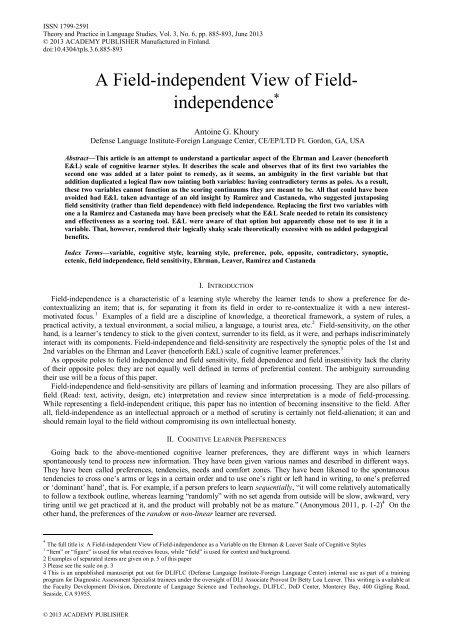Theory and Practice in Language Studies Contents - Academy ...
Theory and Practice in Language Studies Contents - Academy ...
Theory and Practice in Language Studies Contents - Academy ...
You also want an ePaper? Increase the reach of your titles
YUMPU automatically turns print PDFs into web optimized ePapers that Google loves.
ISSN 1799-2591<strong>Theory</strong> <strong>and</strong> <strong>Practice</strong> <strong>in</strong> <strong>Language</strong> <strong>Studies</strong>, Vol. 3, No. 6, pp. 885-893, June 2013© 2013 ACADEMY PUBLISHER Manufactured <strong>in</strong> F<strong>in</strong>l<strong>and</strong>.doi:10.4304/tpls.3.6.885-893A Field-<strong>in</strong>dependent View of Field<strong>in</strong>dependenceAnto<strong>in</strong>e G. KhouryDefense <strong>Language</strong> Institute-Foreign <strong>Language</strong> Center, CE/EP/LTD Ft. Gordon, GA, USAAbstract—This article is an attempt to underst<strong>and</strong> a particular aspect of the Ehrman <strong>and</strong> Leaver (henceforthE&L) scale of cognitive learner styles. It describes the scale <strong>and</strong> observes that of its first two variables thesecond one was added at a later po<strong>in</strong>t to remedy, as it seems, an ambiguity <strong>in</strong> the first variable but thataddition duplicated a logical flaw now ta<strong>in</strong>t<strong>in</strong>g both variables: hav<strong>in</strong>g contradictory terms as poles. As a result,these two variables cannot function as the scor<strong>in</strong>g cont<strong>in</strong>uums they are meant to be. All that could have beenavoided had E&L taken advantage of an old <strong>in</strong>sight by Ramirez <strong>and</strong> Castaneda, who suggested juxtapos<strong>in</strong>gfield sensitivity (rather than field dependence) with field <strong>in</strong>dependence. Replac<strong>in</strong>g the first two variables withone a la Ramirez <strong>and</strong> Castaneda may have been precisely what the E&L Scale needed to reta<strong>in</strong> its consistency<strong>and</strong> effectiveness as a scor<strong>in</strong>g tool. E&L were aware of that option but apparently chose not to use it <strong>in</strong> avariable. That, however, rendered their logically shaky scale theoretically excessive with no added pedagogicalbenefits.Index Terms—variable, cognitive style, learn<strong>in</strong>g style, preference, pole, opposite, contradictory, synoptic,ectenic, field <strong>in</strong>dependence, field sensitivity, Ehrman, Leaver, Ramirez <strong>and</strong> CastanedaI. INTRODUCTIONField-<strong>in</strong>dependence is a characteristic of a learn<strong>in</strong>g style whereby the learner tends to show a preference for decontextualiz<strong>in</strong>gan item; that is, for separat<strong>in</strong>g it from its field <strong>in</strong> order to re-contextualize it with a new <strong>in</strong>terestmotivatedfocus. 1 Examples of a field are a discipl<strong>in</strong>e of knowledge, a theoretical framework, a system of rules, apractical activity, a textual environment, a social milieu, a language, a tourist area, etc. 2 Field-sensitivity, on the otherh<strong>and</strong>, is a learner‘s tendency to stick to the given context, surrender to its field, as it were, <strong>and</strong> perhaps <strong>in</strong>discrim<strong>in</strong>ately<strong>in</strong>teract with its components. Field-<strong>in</strong>dependence <strong>and</strong> field-sensitivity are respectively the synoptic poles of the 1st <strong>and</strong>2nd variables on the Ehrman <strong>and</strong> Leaver (henceforth E&L) scale of cognitive learner preferences. 3As opposite poles to field <strong>in</strong>dependence <strong>and</strong> field sensitivity, field dependence <strong>and</strong> field <strong>in</strong>sensitivity lack the clarityof their opposite poles: they are not equally well def<strong>in</strong>ed <strong>in</strong> terms of preferential content. The ambiguity surround<strong>in</strong>gtheir use will be a focus of this paper.Field-<strong>in</strong>dependence <strong>and</strong> field-sensitivity are pillars of learn<strong>in</strong>g <strong>and</strong> <strong>in</strong>formation process<strong>in</strong>g. They are also pillars offield (Read: text, activity, design, etc) <strong>in</strong>terpretation <strong>and</strong> review s<strong>in</strong>ce <strong>in</strong>terpretation is a mode of field-process<strong>in</strong>g.While represent<strong>in</strong>g a field-<strong>in</strong>dependent critique, this paper has no <strong>in</strong>tention of becom<strong>in</strong>g <strong>in</strong>sensitive to the field. Afterall, field-<strong>in</strong>dependence as an <strong>in</strong>tellectual approach or a method of scrut<strong>in</strong>y is certa<strong>in</strong>ly not field-alienation; it can <strong>and</strong>should rema<strong>in</strong> loyal to the field without compromis<strong>in</strong>g its own <strong>in</strong>tellectual honesty.II. COGNITIVE LEARNER PREFERENCESGo<strong>in</strong>g back to the above-mentioned cognitive learner preferences, they are different ways <strong>in</strong> which learnersspontaneously tend to process new <strong>in</strong>formation. They have been given various names <strong>and</strong> described <strong>in</strong> different ways.They have been called preferences, tendencies, needs <strong>and</strong> comfort zones. They have been likened to the spontaneoustendencies to cross one‘s arms or legs <strong>in</strong> a certa<strong>in</strong> order <strong>and</strong> to use one‘s right or left h<strong>and</strong> <strong>in</strong> writ<strong>in</strong>g, to one‘s preferredor ‗dom<strong>in</strong>ant‘ h<strong>and</strong>‘, that is. For example, if a person prefers to learn sequentially, ―it will come relatively automaticallyto follow a textbook outl<strong>in</strong>e, whereas learn<strong>in</strong>g ―r<strong>and</strong>omly‖ with no set agenda from outside will be slow, awkward, verytir<strong>in</strong>g until we get practiced at it, <strong>and</strong> the product will probably not be as mature.‖ (Anonymous 2011, p. 1-2) 4 On theother h<strong>and</strong>, the preferences of the r<strong>and</strong>om or non-l<strong>in</strong>ear learner are reversed. The full title is: A Field-<strong>in</strong>dependent View of Field-<strong>in</strong>dependence as a Variable on the Ehrman & Leaver Scale of Cognitive Styles1 ―Item‖ or ―figure‖ is used for what receives focus, while ―field‖ is used for context <strong>and</strong> background.2 Examples of separated items are given on p. 5 of this paper3 Please see the scale on p. 34 This is an unpublished manuscript put out for DLIFLC (Defense <strong>Language</strong> Institute-Foreign <strong>Language</strong> Center) <strong>in</strong>ternal use as part of a tra<strong>in</strong><strong>in</strong>gprogram for Diagnostic Assessment Specialist tra<strong>in</strong>ees under the oversight of DLI Associate Provost Dr Betty Lou Leaver. This writ<strong>in</strong>g is available atthe Faculty Development Division, Directorate of <strong>Language</strong> Science <strong>and</strong> Technology, DLIFLC, DoD Center, Monterey Bay, 400 Gigl<strong>in</strong>g Road,Seaside, CA 93955.© 2013 ACADEMY PUBLISHER
















